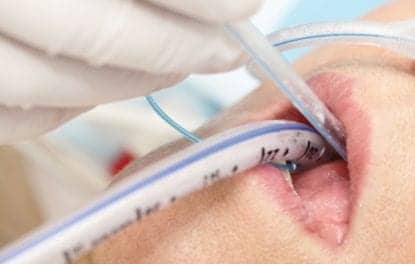RCPs have an evolving role that now involves working with the pulmonologist.
Craig S. Conoscenti, MD
The inhalation therapist of the 1960s and 1970s was a new member of the allied health care team. Initially, those who held such positions were called oxygen therapists, and their jobs entailed rolling oxygen tanks down hospital hallways and starting patients on supplemental oxygen–new and innovative tasks that were sure to help the patient. With the success of oxygen therapists in this role came more responsibilities, such as setting up intermittent positive-pressure breathing therapy, oxygen tents, and ultrasonic nebulizers. This role change resulted in a new name: inhalation therapist. As time passed, the role changed again (as did the responsibilities and educational requirements associated with the position). These changes also led to new titles: respiratory therapist and RCP.
Respiratory therapy, oxygen therapy, and inhalation therapy were task-oriented fields, with specific procedures employed for specific indications. Physicians ordered the performance of these tasks, and they were also changed or discontinued by physicians. Each task was associated with a specific charge to the patient’s insurer and a specific reimbursement to the hospital. Respiratory therapy tasks produced revenue for hospitals, and this allowed continued expansion of the field.
Several factors have since resulted in major changes in respiratory therapy. By the early 1980s, it became evident that the cost of health care was escalating, and all hospital charges were scrutinized by payors. In addition, there was evident overuse and poor allocation of respiratory services. In 1986, Zibrak et al1 reported that when certain respiratory care procedures were eliminated, there was no change in patient outcomes. They suggested that important tasks clearly could not be eliminated, but that others might be omitted in order to decrease costs. Kester and Stoller2 also identified the overutilization of some procedures and the underutilization of others. This task-oriented field, in which some tasks were identified as essential to good outcomes but other tasks were not, became an obvious target for cost-cutting. In response, a shift in orientation from tasks to outcomes resulted in change in both the discipline of respiratory care and the settings in which it is practiced.
Many hospitals have downsized their respiratory care departments, leading to the release of staff members. Some institutions have found other responsibilities for respiratory care staff, who sometimes leave the traditional role of the RCP to perform tasks previously carried out by employees in other job classifications. Other roles for RCPs are new and are performed in areas where RCPs have never before worked. This has created new opportunities for RCPs who might otherwise seek jobs elsewhere or leave the profession.
RCPs who have left the hospital environment have also had to find new opportunities for themselves. Some have taken home-care-related positions with either home respiratory care providers or visiting nurse associations. Others have accepted corporate health care positions. Large corporations, particularly those in industries in which there is occupational exposure to respiratory disease risks, may institute internal respiratory care services staffed by RCPs. Other RCPs in the corporate world have essentially become manufacturers’ representatives for respiratory care products.
Aside from these new roles, RCPs have found another interesting venue in which to practice their speciality: the pulmonologist’s office. In this environment, they can use all their skills and can also develop new areas of expertise. This may call for additional training, but it builds on the foundations that RCPs gained during their original respiratory care education. They find new insight into patient care by caring for patients to whom they are unaccustomed: outpatients who are neither acutely ill nor housebound.
Some RCPs working in pulmonologists’ offices assume only respiratory care roles, performing tasks similar to those that they carry out in hospital settings. These tasks include assessment of the patient and determination of the need for acute therapy, as well as the performance of spirometry, pulmonary function studies, arterial blood gas analysis, and patient education. Other RCPs have assumed a broader role similar to that of a medical assistant. They not only carry out the aforementioned tasks, but also are responsible (after appropriate training) for evaluating and recording vital-sign values, for phlebotomy, and for the performance of electrocardiography and routine laboratory analysis.
Some RCPs have chosen a different career path by attending nursing school and becoming registered nurses (RNs). Their goals have been to make their skills more marketable and to have more doors open to them for employment. In fact, some RCPs have become staff nurses and are now working with only peripheral use of their respiratory care training. Others have used their newly acquired nursing skills to enter the medical-office environment and function at a dual level. These RNs come to the office with the skills that RCPs have learned early in the course of their work.
What does the new availability of RCPs in pulmonology offer to the physician? In their offices, most pulmonologists spend a great deal of time teaching patients simple operations and providing them with basic information (such as appropriate techniques for the use of metered-dose inhalers, the meaning of peak flows and how to use peak flow meters appropriately, and the importance of proper nutrition and exercise). All of these tasks are performed by RCPs in the hospital environment, and they now can be done by RCPs in the office environment as well. Many physicians in all primary care fields have spirometry devices in their offices, but pulmonologists often have full suites of pulmonary function testing equipment. RCPs can be of major assistance to pulmonologists, since they have been trained in pulmonary function testing and they understand the interpretation of these studies (and the therapeutic consequences of their results).
In the hospital setting, RCPs are beginning to employ therapist-driven protocols more widely. Much has been written3-5 concerning these protocols, particularly expressing concern about their acceptance by physicians and about the ability of RCPs to treat the patient adequately by following them. In a recent editorial,3 Hess noted that the only way to develop physician acceptance of these protocols is to develop a partnership between the physician and the RCP. He also pointed out that therapist-driven protocols must cover not only procedures, but specific decision-making processes as well. Better implementation of protocol systems must be accompanied by an understanding of the patient’s disease process.
Although therapist-driven protocols are not currently being used extensively in the office environment, what better way is there to promote the partnership of the RCP and the physician? The close working relationship that exists within an office environment allows interaction to be more meaningful. It permits the physician to appreciate what the RCP knows (and is capable of doing), and it allows the RCP to understand what the pulmonologist has in mind as a goal for a particular patient.
With time, other practice settings for RCPs are certain to develop; the field has not even begun to prepare itself for the doors that may open in the future. For example, urgent care and emergency ambulatory care centers see large numbers of patients with asthma and chronic obstructive pulmonary disease. These centers may become new workplaces for RCPs, as their office experience broadens and becomes more widely accepted. Positions in primary care and pediatric offices involves the same skills, and these sites may open to RCP employment as well. Medical-office work is not suitable for all RCPs, however; the individuals involved in it
must have drive, initiative, and special clinical skills.
The future of respiratory care may call for RCPs to gain new skills while maintaining their traditional expertise. Obviously, this will require change in the way that respiratory care students are educated. As it becomes more common for RCPs to work in pulmonology offices, their training needs will become clearer. At that point, respiratory care curricula can readily be changed to reflect the new needs of RCPs in all settings.
Craig S. Conoscenti, MD, is senior attending physician, pulmonary and critical care medicine, Norwalk Hospital, Norwalk, Conn.
References
1. Zibrak JD, Rossetti P, Wood E. Effect of reductions in respiratory therapy on patient outcome. N Engl J Med. 1986;315:292-295.
2. Kester L, Stoller JK. Ordering respiratory care services for hospitalized patients: practices of overuse and underuse. Cleve Clin J Med. 1992;59:581-585.
3. Hess DR. Professionalism, respiratory care practice, and physician acceptance of a respiratory consult service. Respiratory Care. 1998;43:546-547.
4. Stoller JK. The rationale for therapist-driven protocols. Respiratory Care Clinics of North America. 1996;2:1-14.
5. Shrake KL, Scaggs JE, England KR, Henkle JQ, Eagleton LE. Benefits associated with a respiratory care assessment-treatment program: results of a pilot study. Respiratory Care. 1994;39:715-724.










